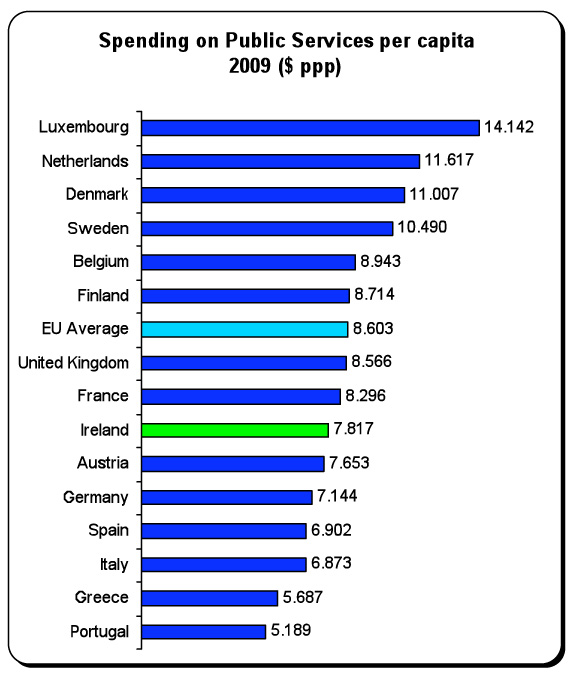A race to the bottom

Fianna Fail wants to cut the number of public service employees by 14,700 over the next four years. Fine Gael has mentioned numbers approaching 30,000. Even Labour proposes public service numbers by 30,000 – though on Twitter Labour stated: ‘The 30k referred to also include 10 to 12k who've already lost their job.’ This would mean, then, 18,000 to 20,000.
All this goes to show that the public sector is in for some serious downsizing regardless of who is in the next government.
Let’s take a step back for a moment. It has been argued in the popular debate that our public services are ‘expensive’. Terms like ‘value for money’, ‘inefficient’, ‘bloated’, etc. have been thrown around over the last two years as if these assertions were rooted in fact. While it’s a big subject let’s look at one aspect: do we spend a lot on our public services? How do we compare with other EU countries?
Here’s what the OECD National Accounts has to say for expenditure on public services in 2009 (note: this only includes spending on public services, not social transfers, interest or capital investment). I have used the Eurostat’s data for population to break it down on a per capita basis.
 As can be seen, Ireland is well down the EU-tables, ranking 9th. We would have to increase spending on public services – health, education, policing, labour market training, sports and culture, etc. – by approximately €3 billion in 2009 just to reach the EU-average.
As can be seen, Ireland is well down the EU-tables, ranking 9th. We would have to increase spending on public services – health, education, policing, labour market training, sports and culture, etc. – by approximately €3 billion in 2009 just to reach the EU-average.
We are already going in the wrong direction. The big cuts in spending on public services will not have hit until 2010, so this year we would be even further behind the average.
With proposals to cut both public sector numbers and non-pay elements (which are essentially purchases from the private sector for goods and services) we should expect to hurtle towards the bottom of the table by 2014.
This is not an argument that every cent of expenditure on public services is ‘efficient’. In an organisation the size of the public sector (after all, it is the state’s biggest employer) it would be truly headline-blazing if there weren’t inefficiencies.
But let's at least put this issue in perspective. Irish spending on public services is hardly excessive. In fact, it is below average – substantially below average. And under a new government it looks set to fall even further.
If the last election campaign deteriorated into a tax-cutting auction, the next election looks set to deteriorate into a fight over who can promise to make the deepest cuts in a public service that is already woefully under-funded.
(Image top via WhatWhat on Flickr)
